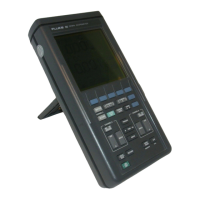CIRCUFT DESCRIPTJONJS
3-7
3.3.3 MICROPROCESSOR
circuitry
(p^P)
•
Introduction
The
ScopeMeter is controlled by a single chip microcomputer with on-board
ROM (called Mask ROM
In the following
text). TNs microprocessor controls the
total system operation and communication
between the
ScopeMeter and the outside world (key
pad,
RS*232-0
interface). It also
controls the
communication
between Internal system components.
*
Detailed circuit
description
See figure 3.2 and
circus diagram A1 (figure 1
0.2).
The ScopeMeter uses
an
Intet
83C196 microprocessor D1201,
with on-board Mask-programmed
ROM (Mask ROM). This
microprocessor has an S-bIt data
bus and a 16-bit address bus. The lower
B address bits
AO.., A7 are combined with the data
brts (multiplexed data bus). ADDRESS
LATCH
D1210 is used
to separate data bits and address bits.
The microprocessor’s
Mask ROM contains the startup software
and a diagnostic kernel test
(see
chapter 7). It also contains
the software necessary to drive
the serial interface and to clear and
program Rash ROMs.
The two Flash ROMs (FRO
Ms)
D1207
and 01208 contain the
system software. The FROMs are
directly connected to the microprocessor
via the datand address
busses. The
microprocessor
addresses the RAMs via the D-ASIC
(D1203).
The microprocessor
contains five 8-bft I/O ports. Port
3
and
4 share their bits with the data and
address busses. The
other I/O ports 0,1,2 are used for vanous purposes.
For example: reading
the
keypad, operating tfie RS-232-C interlace,
battery voltage sense,
switching Ihe power on/off, etc.
Keypad
dreuitry
The keypad
circuitry consists of five shift registers,
01601...D1606, each of which
has eight Inputs.
These inputs
are normally kept "high" by
S6
KIJ resistor arrays
conr\ected to the
+SV supply voltage.
Whenever
a key on the keypad Is pressed,
the corresponding line is connected to
ground, resulting
in
a "low" signal. All signals are clocked into
the shift registers (with the FRONT.CLOCK
and
FRONT.
LATCH signals). Then they
are converted into two signals FRONT
DATA1 (shift registers
D1603, 01604, D1606) and FRONT.OATA2
(D1601 andDl602).
Opi/caity
isolated RS-232-C interface
The serial
communications circuitry, which is built Info
the
microprocessor,
Is used to operate the
infrared (IR) RECEIVER
and TRANSMITTER of the
ScopeMeter. For this purposes stripped
version
of the RS-232-C
protocol is used.
Only the TXD
(transmit data) and RXD (receive
data) lines from the RS-232-C standard
are used.
The IR transmitter
LED HI 201 is driven directly
from the TXD-not pin of the microprocessor.
If a
"0"
IS
transmitted, the LED lights.
The IR receiver
uses operational ^plifler
N1301 to power the collector of phototransistor
HI 202. If
any IR light
Is received, the phototransistor will drive VI 207 in
saturation. This results In a "low" RXD
line, interpreted
by the microprocessor as a
'T.
Battery sense circuitry
The battery voltage -V6AT
generated on the analog unit is
amplified by
-2/3
at operational
amplifier
N1301 . The resulting signal
BAT.LEVEL Is connected
to an A/D converter Input of the
microprocessor.
In this way microprocessor
can monitor the battery voltage
level. If the battery
voltage level
drops below 4.4V, the microprocessor
generates the BATTERY LOW
Indication on the
LCD.

